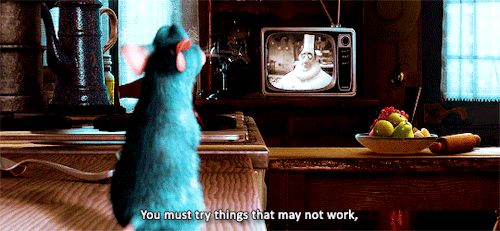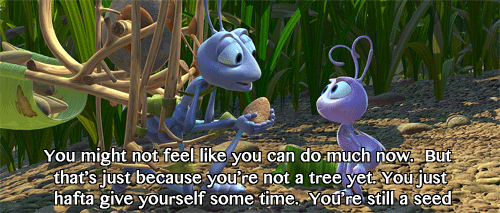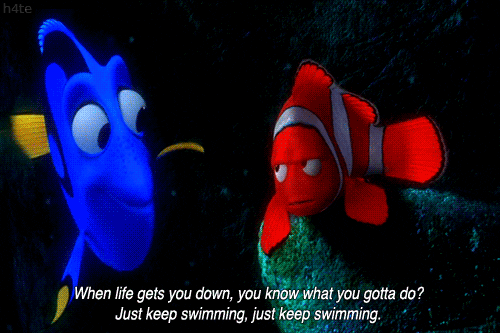Aren’t Pixar movies the best? They have so many lessons to teach us! Lessons about empathy, lessons about perseverance, lessons about the power of nicely cooked vegetables… the list goes on. Just for fun, we took a closer look at several of our favorite Pixar movies to see if we could find some good lessons for nonprofit fundraisers. And we found some great ones!
So, without further ado, here are 8 fundraising lessons we found in Pixar movies.
1. Sometimes you need to abandon the status quo to move forward

One of the most dangerous sentences ever spoken is “But we’ve always done it that way!” That mindset is stifling; it discourages creativity and squashes new ideas. The old way isn’t always the best way!
This was true for Monsters, Inc., and it’s true for us, too. We might not discover that children’s laughter is an ideal energy source (although I bet it’d solve a lot of problems if it was), but we can learn other things, too! Maybe taking a look at processes we’ve always done could reveal that it’s time for change.
Do you put on an event every year that raises little money but has always been done? Do your donors actually want to read your bi-annual financial reports that you mail out, or would they prefer to read it online? Could you improve that program that’s been run the same way for decades to make it more effective?
Take a leaf from Mike and Sully’s book. Abandoning the status quo can be an important part of your growth. Evaluate your processes and your results every once in a while to make sure they’re working for you, not the other way around.
2. Every nonprofit is different, and what works for one organization won’t always work for another…


Who doesn’t love Edna Mode and her amazing super-suits? Nobody, that’s who. And for good reason—she has the remarkable ability to create super-suits designed specifically for each hero’s unique abilities. Violet’s suit can become invisible, Dash has a suit that can withstand his incredible speed, Helen’s stretches with her… you get the idea!
But, just as each suit is unique (because each hero is unique!), your nonprofit needs its own unique set of tools, techniques, and strategies. Helen’s suit wouldn’t work well for Violet, and Dash’s suit wouldn’t work for Jack Jack. Similarly, what works for your nonprofit may not be a good fit for another. The social media campaign that was a huge success for the food kitchen down the street might not work for your animal shelter. You have different missions, donor bases, and areas of expertise!
Experiment and learn what works for your nonprofit. Others’ success may be an inspiration, but remember: you’re unique, and you need to know what works best for you.
3. … But you can still learn from others’ mistakes

Your organization is unique, yes. But that doesn’t mean you shouldn’t learn from other organizations’ failures! There are some things we know don’t work, no matter the organization. Not thanking donors doesn’t work. Sending poorly thought-out appeals doesn’t work. Neglecting your donor database doesn’t work.
Edna Mode won’t let Mr. Incredible wear a cape for a good reason—too many superheroes died that way. Similarly, there are just some things that will always hurt a nonprofit’s reputation or income. Don’t make those mistakes—learn from others!
4. Be willing to try new things and, if you fail, fail forward

In Ratatouille, Chef Gusteau says, “You must be imaginative, strong-hearted. You must try things that may not work, and you must not let anyone define your limits because of where you come from.”
Fundraising is hard! When you’re faced with ever-increasing fundraising goals, it’s easy to go for the “sure bets” instead of trying something new to raise money.
But, often, the “sure bets” we rely on fall flat with our donors. This kind of harkens back to the “abandon the status quo if it’s not working for you” point. Today’s donors are inundated with marketing messages and appeals for their time and money. You need to stand out!
Standing out requires experimentation and new techniques. That requires experimenting, trying new things, exploring new marketing channels, and sometimes failing. Failing is scary. But, when you fail, remember to “fail forward.” Your new techniques or methods may not always be a success, but they are always a chance to learn! When you fail, don’t beat yourself up. Instead, ask yourself questions that will help you win in the future. What did your failure teach you? What did it reveal about your donors? How can you iterate on the idea and improve it?
5. Sometimes that big, scary thing isn’t as scary as it might seem

We all have “that thing” that is scary. For me, it’s talking on the telephone. I hate it. For others, the scary thing is asking for major gifts. Others are intimidated by planned giving. Everyone has a scary thing, but sometimes it only seems scary.
In Toy Story, Rex is a big, scary-looking dinosaur. But, once you talk to him, he’s a lovable dude that always comes through for his friends.
Appearances are deceiving! Often, our proverbial big scary dinosaurs aren’t all that bad. My fear of talking on the telephone tends to dissipate after I’m actually talking to someone. You may find that asking for large gifts or bringing up planned giving may not be as frightening as you thought. The next time you’re intimidated by your scary thing, remind yourself of Rex. It may seem big and scary, but it may be easier than you think!
6. Growth doesn’t happen overnight. Give yourself time!

Working in the nonprofit industry is amazing, isn’t it?
Seeing our peers raise money to effect change in the world is inspiring and can
spur our own creativity and ambitions. But watching others succeed can make us
feel self-conscious, too. The saying “comparison is the thief of joy” often
rings true –, especially
if we feel we’re struggling when others are thriving.
First, always remember that people rarely share their failures with the general public. Then, remember that everyone grows at their own pace. Maybe the person who organized that huge gala you’re envying had a bigger team than you. Maybe they had a larger budget. Maybe their ROI wasn’t as huge as you think. As long as you’re doing the best you can, are trying new things, are learning from your failures and planning for successes, you’re winning. In A Bug’s Life, Flick reminds us you might not be a tree yet, but being a seed is the first step.
7. There’s a time and place for every emotion

In Inside Out, Joy has a really hard time understanding Sadness. Trying to suppress Sadness ended up causing a lot of problems, and it wasn’t until Sadness was able to play her role that things started turning around.
More than most groups of people, fundraisers are exposed to a ton of emotional situations. We’re heartbroken by the problems we see in our communities. We’re overjoyed when we see our hard work making a difference. We’re angry when we see injustices. The list goes on!
Feelings are hard to navigate, especially when society as a whole gets uncomfortable when faced with “negative” emotions. But listen to me, fundraisers: there is a time and place for every emotion. Use your anger about injustice to fuel your passion for change. Pour that passion into your donor base and get them fired up about making the world a better place. Use the sadness you feel when you see your community’s problems and let it strengthen your resolve to do good. Don’t let people put you down for being emotional. Instead, embrace the fact that your emotions are powerful motivators for change.
8. The hard parts are temporary

Everyone experiences ups and downs. For fundraisers, it’s part of the job. The highs are always great, but it’s important to acknowledge the lows, too. Sometimes, it feels like the highs are fleeting and the lows go on forever. That’s when it’s time to channel Dory and just keep swimming.
The low parts of a fundraiser’s day-to-day vary, but they’re only temporary. That donor sending in a smaller gift than normal, that disagreement with your board chair about reasonable fundraising goals, the last-minute cancelation that threatens to tank your gala… it’s all temporary. Just keep swimming.
Now, that being said, I will say this: there is a difference between temporary lows and systemic problems. Burnout is a huge problem in the nonprofit industry, and burnout takes a serious toll on our mental, emotional, and physical health. “Just keep swimming” is great advice when we’re navigating the highs and lows that are inherent to every job. But you can’t easily fix systemic problems. If you’re experiencing burnout, please prioritize your health and safety!
Conclusion
Should we take all our life lessons from Pixar movies? Nah. Can we have a lot of fun looking at Pixar’s little takeaways and applying them to our careers in the nonprofit industry? Heck yeah we can!
You’re a force for good in the world. Try new things, learn from your mistakes, grow and expand, and just keep swimming. The world is better with you in it. Now get out there and fundraise. You can do it!



